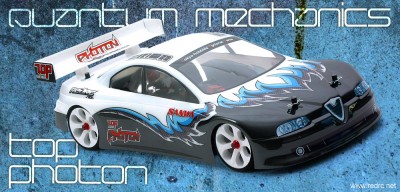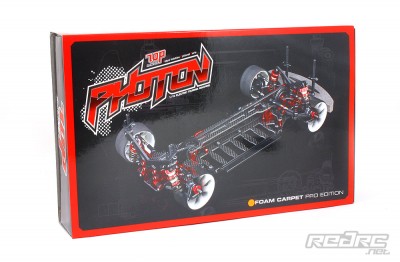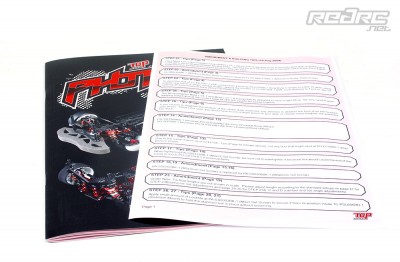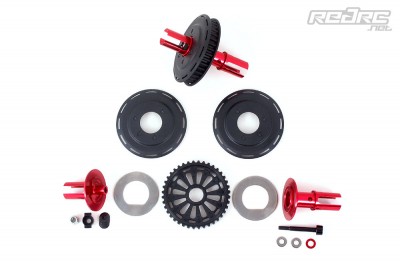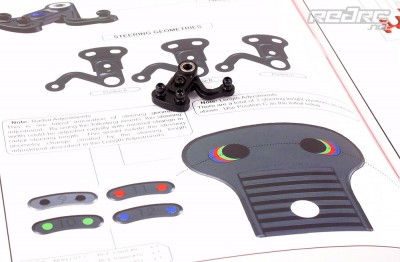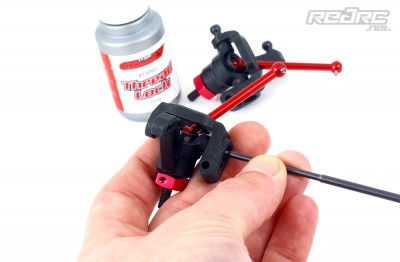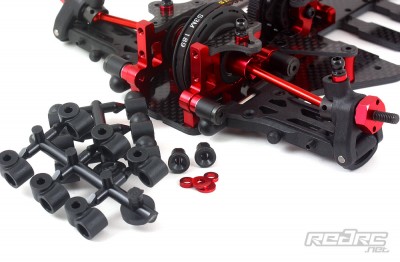Quantum Mechanics – TOP Racing Photon
TOP Racing’s Photon touring car concept was introduced some time ago with the help of some very nice CAD images. Now the 1/10 scale electric touring car is finally available to everybody and we are happy to get our hands on the tasty looking Foam Carpet edition. The car is designed by US on-road wizard Josh Cyrul and features some very nice details such as easy-access front and rear differentials, a specially designed LiPo battery retaining system and other gimmicks that make the Photon stand out from the rest of the current crop of electric touring cars.
TOP Racing’s Photon is delivered in a handy box, suitable for both the rubber and foam tyre spec cars, so be aware of getting your hands on the correct version. The car that comes within the cardboard package is marked with an orange dot on the upper or lower side of the outer packaging. The kit comes with assorted bags for every step of the build. The quality of the parts is very good with nicely machined full carbon parts and red anodised aluminium alloy parts. The red coating is of a good quality with the front and rear universals appearing in a brighter red than the shock and bulkhead parts.
The supplied parts with the kit differ between the rubber and the foam tyre chassis. Our foam spec car comes with front differential, front alloy universals, different chassis braces, harder front springs and a 1.4 mm front sway bar, while the rubber spec edition comes with front spool and steel universals, smaller carbon chassis braces, softer front springs and 1.2 mm sway bars all round. Also the carbon fibre material differs, as the foam carpet spec makes use of less flexible bidirectional carbon fibre plates while the rubber tyre version comes with a more flexible unidirectional chassis plate. Both specs share a very trick LiPo battery mounting system consisting of adjustable plastic rails to accommodate different sized hardcase packs in combination with a very clever system to add additional weights for a proper side-by-side balance of the chassis.
Front
The build starts with the front and rear ball differentials. The manual supplied with the kit consists of CAD drawings, parts lists and comments for both versions so please make sure you pick the correct steps for your type of chassis. Also supplied is an amendment and build tips sheet so building the Photon needs a bit of concentration to not mix-up things especially in the later stages of the suspension build.
If not stated otherwise we followed the build tips provided and wrenching on the differential is pretty much straight forward. As usual with most electric on-road kits we used Associated Black Grease on the thrust races and Corally differential lube on the ‘big balls’ as no greases are supplied with the kit. The front differential is located in a four piece bulkhead set-up. Two of which house the differential with its eccentric plastic cams that also allow for the tension of the front belt to be adjusted. The two rearmost parts of the bulkhead, connected to the foremost ones by CF ‘wings’, surround the central steering crank.
The steering Ackermann geometry is adjustable via different inserts for the crank as well as by sliding the inner ball stud mount back and forth. The inserts are meant to eliminate the need to adjust the length of the steering linkage when sliding the inner ball stud mount back and forth. The result is a more consistent steering set-up as you only change the inner ball stud position and not the length of the steering. Sounds complicated but shows the degrees of perfection TOP wanted to achieve with the new Photon. Attached to the bulkheads via different plastic pivot supports are two very sturdy wishbones. These clever moldings are usable both on the left and right hand side, plus if you flip them they offer a total of three different mounting positions for the lower damper pivot.
The outer steering arm is held in place by a C-hub assembly, the outer suspension pins are held in place by grub screws. All steering and camber links on the Photon are of an ‘open’ design making suspension geometry changes easy as you do not have to detach the ball cup from the ball joint. The differential is held in place by two carbon fibre plates that also act as inner attachment positions for the upper camber links. This helps to speed up maintenance and tuning as the suspension stays in place, which is different to similar chassis designs with combined shock tower and bearing retainer parts that have to be detached from the bulkheads for diff access.
The suspension mounts are supplied with different settings to adjust roll centre and kick-up to suit different track conditions and driving styles. Track and wheelbase are adjustable via different thickness shims. The carpet foam edition comes with a 1.4 mm front stabilizer that attaches via a total of four ball joints to the lower wishbones. Thicker and thinner wires for the stabilizer are available as thin as 1.0 mm and as thick as 1.8 mm.
